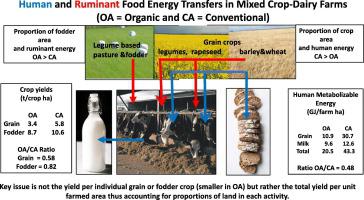Agricultural Systems ( IF 6.1 ) Pub Date : 2022-03-16 , DOI: 10.1016/j.agsy.2022.103404 David J. Connor 1

|
CONTEXT
Most information on relative yield of organic (OA) and conventional agriculture (CA) is from plot experiments of individual crops grown with organic or inorganic fertilizers, respectively. Commonly reported values are 0.75–0.91, a relatively small difference. But organic manures are produced through biological nitrogen fixation (BNF) by legumes. How much and what else does that land in legumes contribute to overall yield?
OBJECTIVE
Establishment of OA/CA yield ratios for crop-dairy production at regional scale accounting for proportions of land in crop and fodder production and their contributions to overall food yield using human metabolizable energy (HME) as a unifying parameter of yield of grain and milk.
METHODS
Average yield of grain and fodder crops per unit farm area for OA and CA in eight regions of Sweden were converted to human (HME) and ruminant metabolizable energy (RME), respectively. Two diets for dairy cattle were constructed to maximize either yield of HME in grain plus milk (maxHME) or in milk (maxmilk) from all grown fodder supplemented by crop products while maintaining overall diet quality at 15% crude protein (CP).
RESULTS AND CONCLUSIONS
Average regional annual primary production (dry biomass), including crop residues, of 6361 (range 4862–7793) kg/ha for OA was less than 9223 (range 6337–12,910) kg/ha in CA. OA had greater proportion of land in fodder crops and pasture (65%, range 38–87%) than CA (30%, range 11–86%). Total HME yields (grain plus milk) were less in OA than CA but with large variation between regions, maxHME OA 21.2 (range 11.0–30.4) GJ/ha and CA 43.6 (16.2–82.1) GJ/ha and maxmilk OA 19.9 (range 9.1–27.4) GJ/ha and CA 42.9 (range 16.0–80.9) GJ/ha. Regional OA/CA HME-yield ratios ranged from 0.43 to 0.74, with greater values in northern regions of low productivity where crop intensification is constrained by low temperature.
SIGNIFICANCE
This analysis establishes smaller relative yields of OA than are commonly reported. Smaller yields per crop area in OA are further reduced at farm (system) level relative to CA by the larger proportion of land required in legume-based crops and pastures. Ruminant animals provide some compensation for that land by converting human-inedible fodder to human food. Consequently, transformation of CA farmland to OA would require additional land, up to 130% in productive southern and central regions, to maintain equal overall yield. More such comprehensive data are required for calculation of OA/CA yield ratios at the system level.
中文翻译:

有机农业中的粮食相对产量和土地利用效率——一项区域研究
语境
大多数关于有机(OA)和传统农业(CA)相对产量的信息来自分别使用有机或无机肥料种植的单个作物的小区实验。通常报告的值为0.75-0.91,差异相对较小。但是有机肥是通过豆科植物的生物固氮(BNF)产生的。豆类中的土地对总产量有多少贡献?
客观的
使用人类代谢能 (HME) 作为谷物和牛奶产量的统一参数,确定区域规模的农作物-乳制品生产的 OA/CA 产量比,占农作物和饲料生产中土地的比例及其对总粮食产量的贡献。
方法
瑞典八个地区的 OA 和 CA 单位农场面积的谷物和饲料作物的平均产量分别转换为人类 (HME) 和反刍动物代谢能 (RME)。构建了两种奶牛日粮,以最大限度地提高谷物加牛奶 ( maxHME ) 或牛奶 ( maxmilk ) 中的 HME 产量,来自所有生长的饲料,辅以农作物产品,同时将总体日粮质量保持在 15% 粗蛋白 (CP)。
结果和结论
OA 的区域年平均初级产量(干生物量)(包括作物残留物)为 6361(范围 4862-7793)kg/ha,低于加州的 9223(范围 6337-12,910)kg/ha。OA 在饲料作物和牧场中的土地比例(65%,范围 38-87%)高于 CA(30%,范围 11-86%)。OA 的总 HME 产量(谷物加牛奶)低于 CA,但区域间差异很大,maxHME OA 21.2(范围 11.0-30.4)GJ/ha 和 CA 43.6(16.2-82.1)GJ/ha 和maxmilk OA 19.9(范围9.1–27.4) GJ/ha 和 CA 42.9 (范围 16.0–80.9) GJ/ha。区域 OA/CA HME 产量比在 0.43 到 0.74 之间,在作物集约化受低温限制的北部低产地区的值更大。
意义
该分析确定 OA 的相对产量比通常报告的要小。由于豆科作物和牧场所需的土地比例较大,OA 中每作物面积的较小产量在农场(系统)水平上相对于 CA 进一步降低。反刍动物通过将人类不可食用的饲料转化为人类食物,为这片土地提供了一些补偿。因此,将 CA 农田转变为 OA 将需要额外的土地,在生产性南部和中部地区高达 130%,以保持相同的总产量。在系统级别计算 OA/CA 收益率需要更多此类综合数据。











































 京公网安备 11010802027423号
京公网安备 11010802027423号